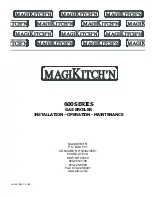
Hand over the User Booklet and the completed
Benchmark Logbook and/or, in Eire, the Declaration .
Explain how to operate the appliance safely and efficiently.
Tell the user what to do if the appliance is not to be used in very
cold conditions.
Tell the user what to do if the system pressure falls.
Explain that regular servicing will maintain the safe and efficient
operation and extend the life of the appliance. Worcester Heat
Systems or their agent can offer a comprehensive maintenance
contract.
Tell the user that any work on the appliance must only be
carried-out by a competent, CORGI (in the UK) registered, person.
15.1
To ensure continued efficient operation of the appliance it
must be checked at regular intervals. The frequency of servicing
will depend upon the particular installation conditions and usage,
but once per year should generally be adequate. The extent of the
service required by the appliance is determined by the operating
condition of the appliance when tested by fully qualified engineers.
Any service work must be carried out by competent registered
engineers (CORGI in GB).
15.2 Inspection
Check that the terminal and the terminal guard, if fitted, are clear
and undamaged.
If the appliance is in a compartment or cupboard check that the
specified service space around the appliance is clear. Refer to Table 8.
Check all the joints and connections in the system and remake
any that show signs of leakage. Refill and re-pressurise as
described in Section 13-Commissioning.
Operate the appliance and take note of any irregularities. Refer to
Section 19-Fault Finding for rectification procedures.
15.3 Combustion performance
It is not normally necessary to check the combustion
performance of the appliance. A sampling point is, however,
provided. Refer to Fig. 38.
The combustion performance figures given are for guidance.
Remove the cap from the sample point on the top of the
appliance.
Connect the approved sampling meter.
With the appliance at maximum rate and stable in the DHW
mode expect readings of:
NG CO
2
6.5—7.5% CO 0.002—0.010%
LPG CO
2
7.5—8.5% CO 0.002—0.010%
NOTE:
For flues greater than 725mm without a restrictor the CO
2
may be up to 0.5% lower.
These figures cover all flue conditions.
Refit the cap after the test.
15. Inspection And Service
22
Fig. 37. Facia controls
1
1. Central Heating temperature control and On/Off knob
2. System pressure gauge
5. Fault indicator and
3. Burner ON indicator
reset button
4. Optional timer
6. User guide location
2
3
4
6
5
Fig. 39. Inner case and facia fixing
3
1. Inner casing cover
2. Cabinet fixing screws (2)
3. Inner casing cover fixing screws (2)
4. Facia control panel
5. Controls connector cover
6. Controls connector cover fixing screws (2)
7. Programmer (optional)
8. Facia control panel fixing screw
9. Top support lug
10. Bottom support lug
1
4
6
2
5
6
9
2
7
8
10
1
2
Fig. 38. Combustion Test Point
14. Hand Over
1. Flue connections
2. Combustion products test point
















































